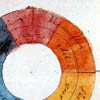

Colours are the deeds of light; its deeds and sufferings: thus considered we may expect from them some explanation respecting light itself.
DESCRIPTION
The pssvg program converts Photoshop grd5 gradients to the SVG format. Unlike most of the other file formats handled by the cptutils package, grd5 files may contain multiple gradients and all of the input gradients will be converted to gradients in the output file. One can then use svgx (1) to extract single gradients and convert them to other formats.
Photoshop gradient files will often contain a number of gradients with the same name. These
names are used as the basis for the SVG titles (the id
attributes), but since these must be unique, the program will append _01, _02, ... to duplicate names in order to form
the titles. Alternatively once can employ the --title option to
generate a uniform sequence of titles.
The program will read from stdin if a file is not specified as
the final argument, and write to stdout if the --output option is not specified.
OPTIONS
In the following, all rgb specifications should be
of the form red/green/blue where the
colour components are integers in the range 0 to 255.
-b,--backgroundrgb-
Set the background colour of the output.
--backtrace-filepath-
Specify a file to which to write a formatted backtrace. The file will only be created if there is a backtrace created, typically when an error occurs.
--backtrace-formatformat-
Specify the
formatof the backtrace written to the files specified by--backtrace-file, one ofplain,xmlorjson. -f,--foregroundrgb-
Set the foreground colour of the output.
-h,--help-
Brief help.
-o,--outputpath-
Write the output to
path, rather thanstdout. -t,--titleformat-
This option generates the SVG gradient titles (the
idattributes) according to the specifiedformat.The
formatargument should be a printf (3) format string containing a single integer directive (and that directive will be replaced by the gradient number). Thus "gradient-%03i" will produceids "gradient-001", "gradient-002", ... -v,--verbose-
Verbose operation.
-V,--version-
Version information.
EXAMPLE
Convert a Photoshop gradient, foo.grd, to a set of GIMP gradients, foo-001.ggr, foo-002.ggr, ...
pssvg -v -t "foo-%03i" -o tmp.svg foo.grd svggimp -v -a tmp.svg
CAVEATS
The program handles RGB, HSB, LAB, CMYK and greyscale colour stops, converting them all to RGB and then merging the results with the opacity channel to create SVG RGBA stops. Conversion of non-RGB stops is naive and takes no account of colour profiles, so the results are generally sub-optimal. Integration of a CMS (colour management system) into the program to perform these conversions is under investigation.
The program does not handle "Book Colours" (PANTONE, COLOR FINDER, etc) for legal reasons.
The SVG output format does not support back/foreground colours; consequently, if the input
specifies any stops with back/foreground colours then these will be converted to the colour
specified by the --background and --foreground options, respectively.
The smoothness parameter used by Photoshop (which seems to parameterise some kind of spline) is not yet handled; the output contains only linear splines (corresponding to a smoothness of 0%). The result is that the SVG output will sometimes look more "angular" than the Photoshop input. Fixing this will require research into the precise nature of the spline parameterisation used in the input.
Noise gradients would seem to be difficult to convert to SVG without using a huge number of stops in the output, so these will probably not be supported by this program.
NOTES
Adobe Photoshop® is a trademark of Adobe Systems Inc. PANTONE® is a trademark of Pantone LLC. COLOR FINDER® is a trademark of Toyo Ink Mfg. Co., Ltd.
This program was written using the reverse-engineered specification of the grd5 format by Valek Filippov, Alexandre Prokoudine and Michel Mariani.